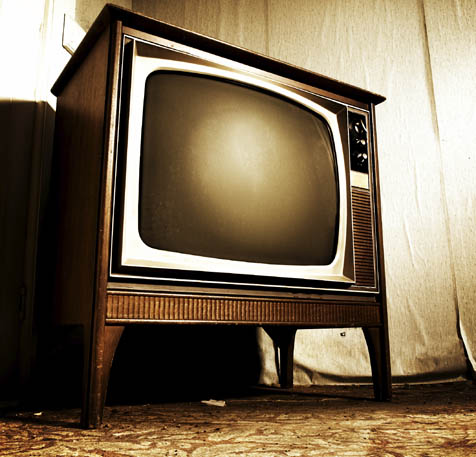How the Health Insurance Crisis is Ruining Antiques Roadshow
Heirloom Deflation

Iwent through a phase where I just loved to watch Antiques Roadshow. I find it peppy and soothing, predictable and amazing, a wonderful amalgamation of historic America and middle America, naivete and expertise, innocence and greed.
I settle in happily to hear the litanies of acquisition: “When my grandfather passed away :”; “My parents were living in South America :”; “My husband and I went to a church sale :”; “My great-grandmother’s sister ran an antique shop :” Of course, I want to know instantly what the item is worth, but I especially like observing the reactions of the hopefuls, who feign joy badly at low appraisals or try not to show it at high ones. From the prim, “Oh, well, thank you” (photographs of Indians, $30,000) to “I guess I’ll have to stop using it as an umbrella stand” (Weller Woodcraft vase, $1,500) to “Ooh, ooh, ooh” (Tiffany tea service, $8,000-$12,000) to “Oh my God, thank you. I had no idea. Oh my God, wow.” (Vermont militia coat, $25,000-$30,000), I study every exclamation and facial expression for truth or fakery. Was that $25,000 really an “Oh my God, wow”? Or were they secretly counting on $250,000?
I assure my inner couch potato that the program is educational. For instance, I learn that a Santa Claus figure dressed in any color but red is worth much more money. A Barbie with a bent knee is the most desirable. Old guns and guitars are goldmines. Baseballs signed by Ty Cobb are king. Indeed, I savor the notion that I could now go to a garage sale or thrift store with the savvy to spot the real French art glass, the pink-and rarest of-Hot Wheels, a hairy paw-foot table, or a humble and incredibly valuable wooden duck decoy.
I find the definite delineation of dates, the provenance of artists, and the history of craft movements to be comforting. And as someone whose greatest dread is that I might end up living in a trailer-or a car-the possibility that I too might stumble across a Milton Avery painting in my attic, or a Tiffany necklace in my mother-in-law’s costume jewelry, or a Mexican sword stashed in a closet, gives me hope for the future. I can hear the battle cry “We’re rich!” resounding through the airwaves.
Here’s a tiny little Steiff horse, “great condition, except for its mane and tail,” brought in by a woman with bangs and big teeth. She learns the Chanukah gift she received at age three is worth $2,000. I’m thinking, isn’t that great, when I suddenly realize, wait a minute, we pay more than that for two months of health insurance. I would’ve had to have been given six toy horses to pay for one year of health insurance. Add in the deductibles and it should have been 12 horses. Who gets 12 horses for Chanukah?
Like the one bad apple that spoils the barrel, soon I’m translating every triumph and disappointment on Antiques Roadshow into an exercise in painful bill paying. Instead of enjoying the simple pleasures of the show, I obsess about how our health insurance payments are bleeding (hemorrhaging, actually) our assets. In the pastoral, nostalgic, utopia evoked by the TV show, the lovely prints that your great aunt bought in Japan are now worth a hundred or a thousand times their original price. In reality, what we pay in health insurance premiums in a year would be enough for a down payment on a house or a decent used car.
And it’s not just our family. I see it all around us with those who are self-employed or changing jobs. Penalized if they go to the doctor, distrusted if they don’t. Catapulted into high risk if their cholesterol is too high or their weight is too low. And regardless of the economy, the morality, or the reality, the companies assert-and take-their unchallenged right to raise and raise and raise their rates.
One of the Antiques Roadshow experts interviews a woman with Indian baskets, traded decades ago for bags of flour. He tells her they’re worth $8,000-$12,000 each. “It’s a collector’s dream,” he gushes. “It’s the best I’ve ever seen. Ever. At any time.” And I wonder, is my insurance company looking at one year of our premiums and noting, “It’s an insurance company’s dream. It’s not the best we’ve seen-other people pay more. But just think, it’s a mere drop in the Niagara Falls gush of our revenues. Hey! Let’s build another skyscraper and give our CEO a $3 million raise!”
I turn on the show again, and try to revive the thrill of this national treasure hunt. Imagine that! An odd, funky, mustard-colored piece of pottery, one handle blown off in the firing, with the crude signature of a slave named Dave, is now worth $15,000-$20,000. I try to get excited. Very rare, historically significant, museum quality. Yes, but it’s worth fewer than two years of health insurance. It boggles the mind. My simple pleasure in the show has been co-opted. Where is the opiate of the masses when I need it?
Antiques Roadshow is all about the serendipity of fortune-mostly good. Our health insurance situation-and millions of others’-seems to be about the serendipity of bad fortune. I feel like a pawn forced to play a huge game of roulette, betting a significant portion of our income so that we won’t be bankrupted by a catastrophe. Would I be better off joining the 41 million uninsured who are betting (or praying) they won’t need it?
It seems that either way, I lose.



